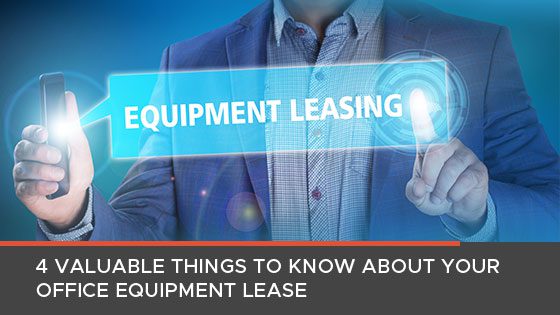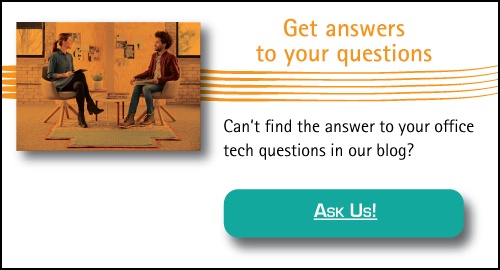Purchasing ownership of something is a pretty simple concept. Pay cash for an item, and it’s yours. From that moment on, you’re free to do as you please.
Leasing, on the other hand, can feel far more complicated for many people. It features unusual language and contractual obligations that don’t have a familiar analogue in most peoples’ day to day lives.
Unfortunately, this leads many business owners to unfairly discredit leasing as a viable alternative to purchasing office equipment. The truth is that the office equipment lease is a structured and logical arrangement that often suits the interests of precisely these types of business owners best.
Anyone who is unfamiliar with leasing will want to familiarize themselves with four critical concepts before signing off on an agreement. There are many different types of leases, and identifying your needs is crucial to making the lease agreement work for you.
How an Office Equipment Lease Works
On the surface, leasing seems similar to renting – and to some degree, it is. Leases give you the ability to borrow expensive equipment without having to scrape up enough capital to make a down payment for a loan.
Instead of borrowing capital to buy equipment, you can borrow the equipment and pay a fee for as long as you need it. This makes leasing an excellent option for equipment that depreciates in value or that becomes obsolete in a shorter timeframe than most bank loans assert.
Nobody wants to spend five years paying for equipment that goes obsolete in two years.
But many factors can affect the basic structure of an office equipment lease agreement. The four most important ones to look out for include:
1. Terminology and Definitions
This is where many business owners hit a brick wall when it comes to leasing. Lease agreements use terms that you never see in daily life.
For instance, the lessor is the company that owns an asset. The lessee is the person borrowing it under the terms of the lease agreement. Amortization refers to the way an asset’s value is distributed over its life – the list goes on.
There are dozens of terms to know, but you don’t have to study them all before you start the leasing conversation. Don’t be afraid to admit when you don’t understand a term and ask your leasing partner to explain what it means.
2. Maintenance and Responsibility
The idea of an office equipment lease is to use equipment without having to own it. But if you don’t own the equipment, who is responsible for maintaining and repairing it? This is a critical aspect of the lease agreement that you will want to discuss with your lessor.
Sometimes, the lessor retains responsibility for keeping equipment in good running order. But ownership-oriented leases will often transfer maintenance responsibilities to the lessee. This is one area where you want to avoid unwelcome surprises.
3. Ownership or Return
Unlike ownership, a lease is temporary. Your lease contract specifies the duration of your lease agreement and will stipulate both the lessee’s and lessor’s options at the end of the lease.
Instead of avoiding the decision of whether to own or return equipment at the end of the lease, make a plan describing where you see the assets going when the contract is up. You can structure your lease to make ownership easier by spreading the cost of equipment throughout the lease term. This is called a $1 buyout lease.
Alternately, you can sign a fair market value lease that offers the lowest possible monthly payments. This arrangement increases the cost of purchasing the assets once the term is up if you choose to do so.
If you decide to return the device at the end of the lease be sure to read the fine print in your contract as to whether you or your provider is expected to shoulder disposal and removal costs. Depending on the size of the equipment and your office’s location, you could be looking at removal costs in the hundreds or even thousands of dollars.
4. Asset Depreciation
If you are not entirely sure whether you want to own or return the equipment you want to lease, depreciation can guide you in the right direction. The faster an item’s value or utility depreciates, the less attractive owning it becomes.
Take both value and utility into consideration. A pick-up truck may depreciate but remain useful for decades. A computer server, on the other hand, will both depreciate and become less useful as newer, more capable equipment enters the market, and hardware compatibility becomes an issue.
Calculate Lease Costs Against Purchase Costs
Lease agreements allow cash-strapped businesses to deploy new equipment without having to expose themselves to massive debts. However, leases do tend to cost more in total over the life of the lease compared to purchasing equipment outright with cash.
Try to negotiate equipment maintenance and find ways to write lease payments off your tax obligations. You may be able to drastically reduce the overall cost of your office equipment lease compared to the cost of ownership.
Still not sure if you should buy or lease? You’re in luck; we wrote an article on just that! Check out Buy or Lease? The Pros & Cons of Buying or Leasing Office Equipment for a breakdown on which option is best for you.
Cory Porteous
Marketing Manager
Office Interiors



